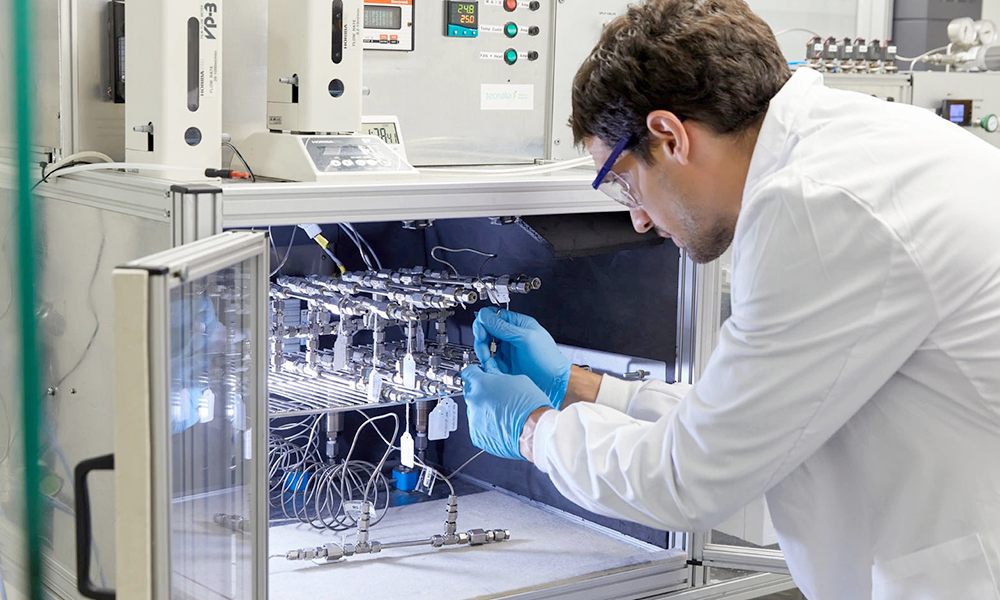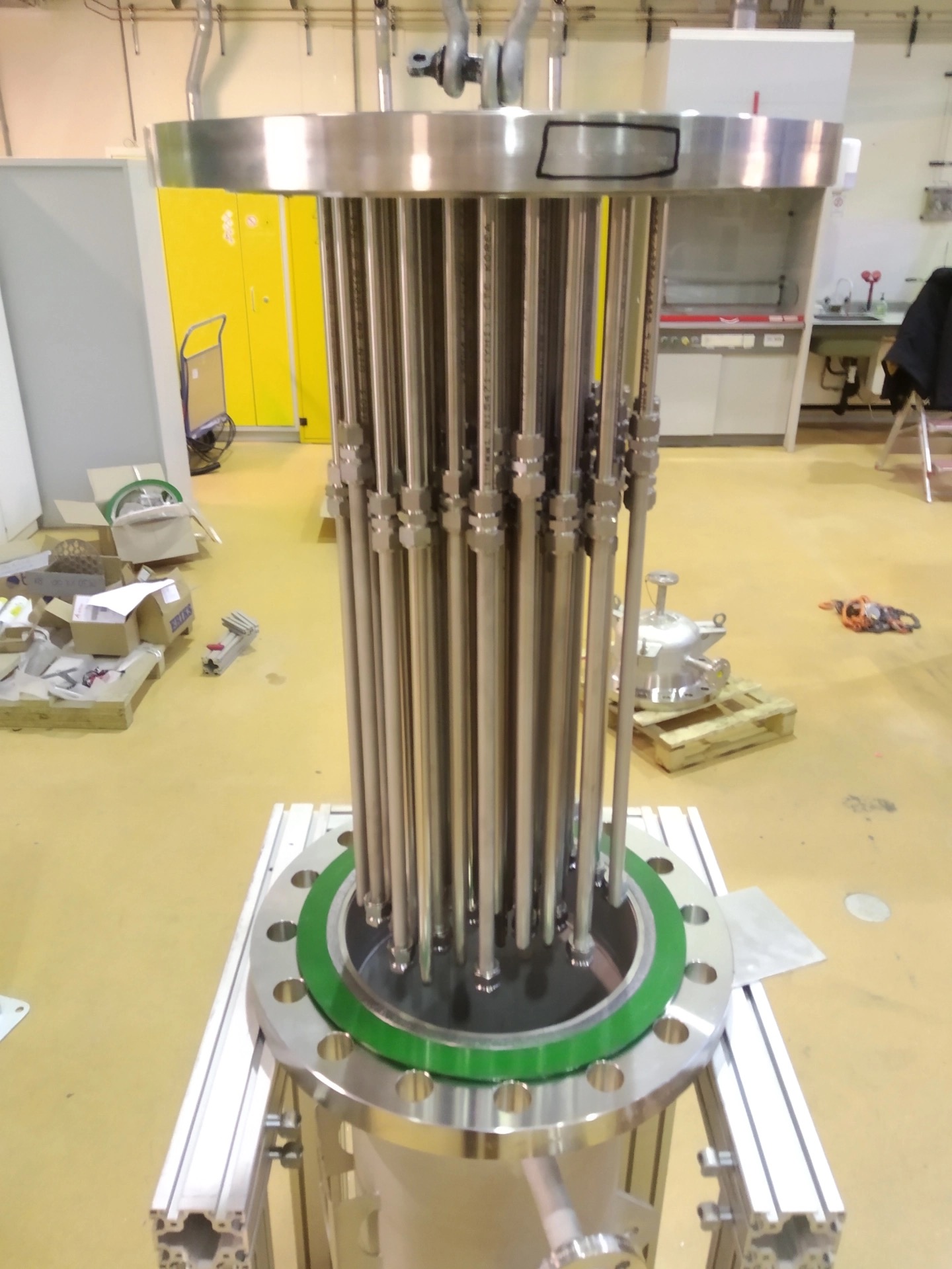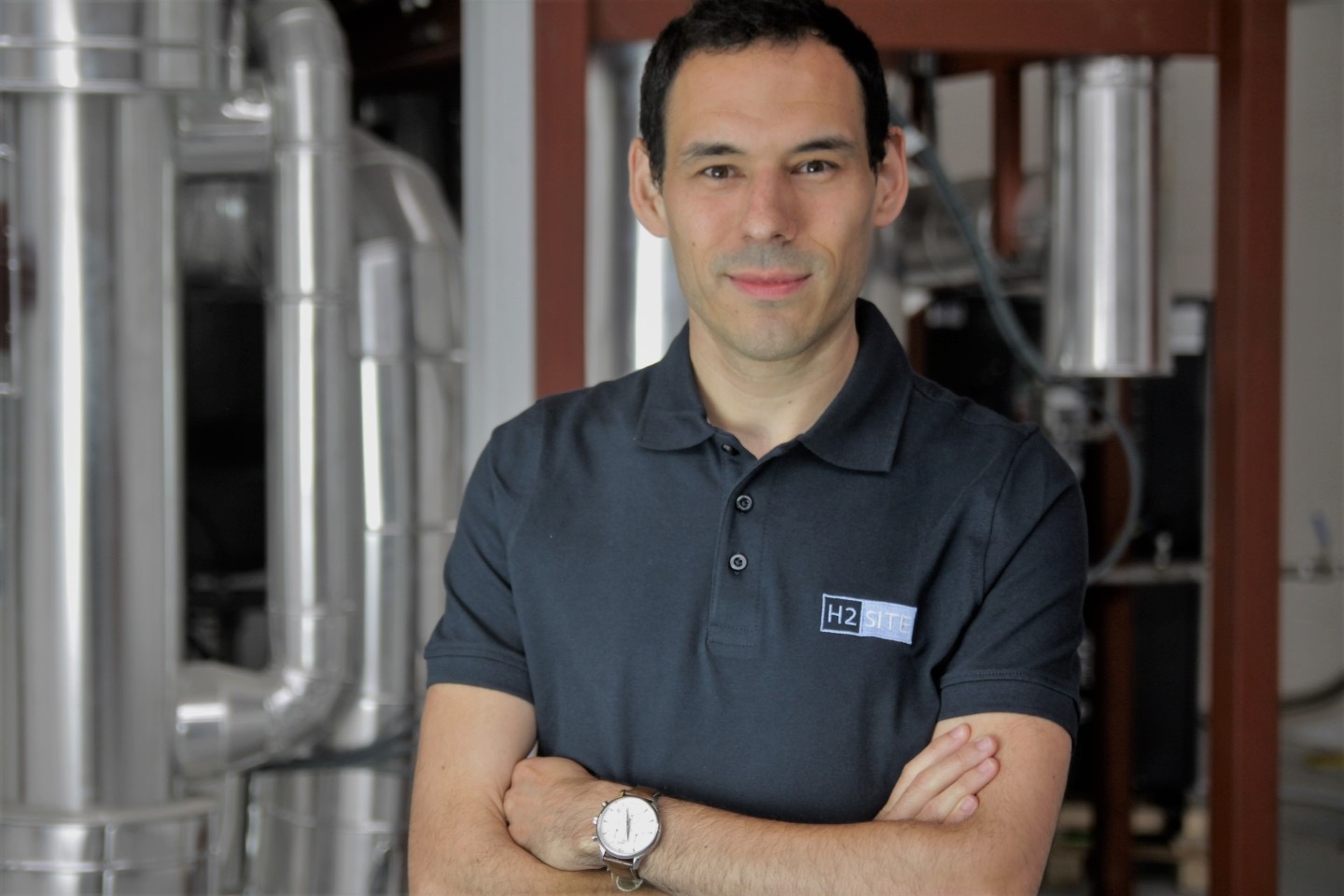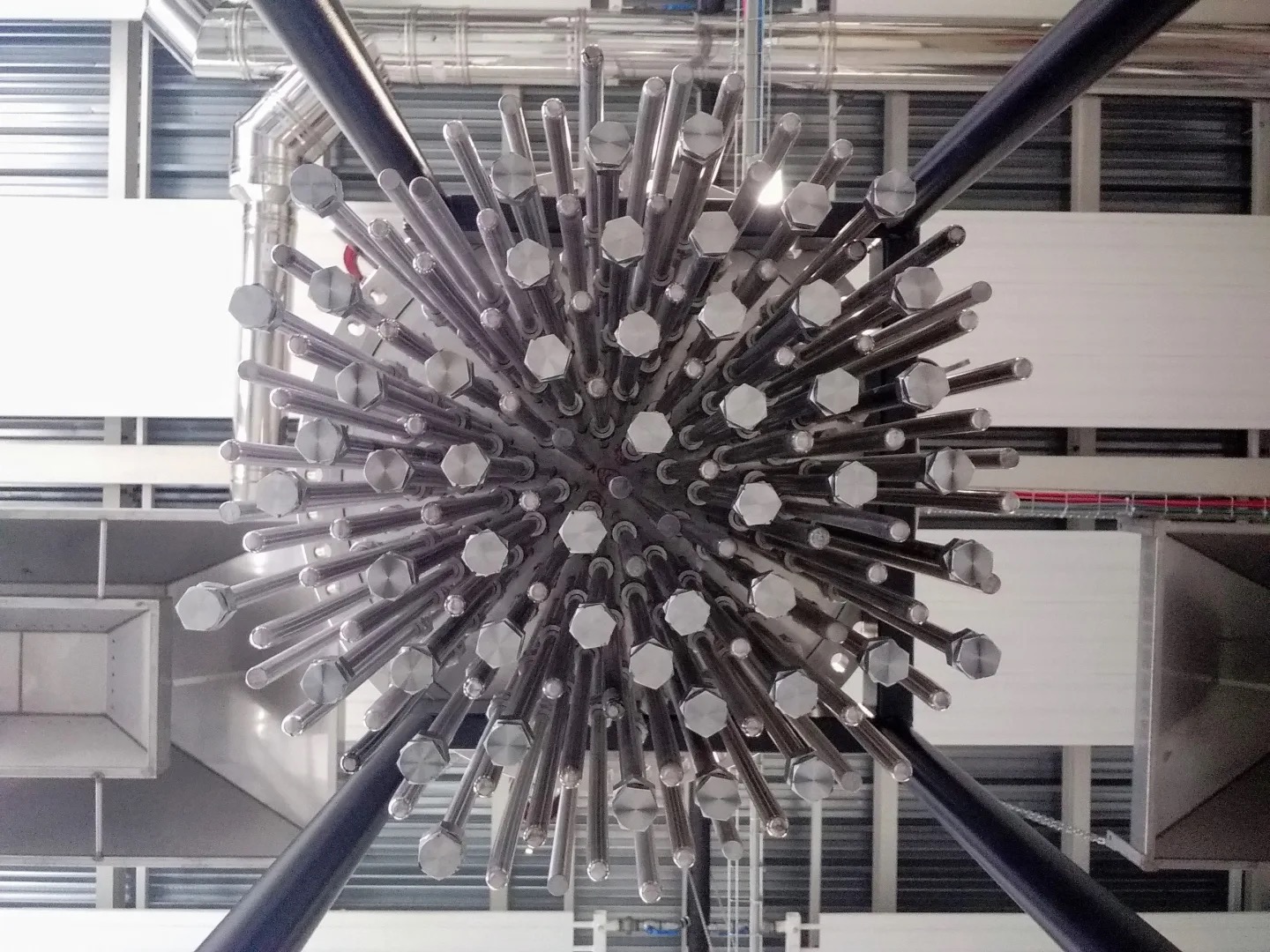
在這個迫切需要清潔能源的世界,綠氫可謂是救命稻草:零碳,、儲量豐富而且具有廣泛用途。然而,,我們依然無法充分發(fā)掘綠氫的潛力,。
多年來,,氣候活動家一直在積極呼吁,讓煉鋼和原油冶煉等行業(yè)使用零碳?xì)淙剂蟻砻撎?,而這些行業(yè)一直都依賴 “灰氫”(化石能源制氫,,生產(chǎn)過程中會伴隨二氧化碳排放)。很快,,綠氫就將成為卡車,、公共汽車,甚至輪船和飛機(勞斯萊斯正在測試氫燃料飛機引擎)的燃料,,并通過燃燒來供熱和發(fā)電,。
然而,所有這一切美好的承諾都存在一個“攔路虎”:人們當(dāng)前無法以較為經(jīng)濟(jì)的方式大規(guī)模地把氫氣從產(chǎn)地(利用豐富廉價的可再生能源制氫)運輸?shù)绞褂玫?,例如從西班牙運輸至北非,、阿曼和澳大利亞。
西班牙氫氣運輸初創(chuàng)企業(yè)H2SITE首席執(zhí)行官安德烈斯·加納雷斯(Andrés Galnares)表示:“運輸是氫氣利用的痛點,?!贬槍@一難題, H2SITE給出的解決方案是一種膜反應(yīng)器(membrane reactor),,這是一種過濾系統(tǒng),,能夠讓現(xiàn)有的管道迅速、低成本地將綠氫從產(chǎn)地運輸至最需要的地方,。
H2SITE 6月份獲得1250萬歐元(約合1280萬美元)的A輪融資,,由比爾·蓋茨創(chuàng)立的Breakthrough Energy Ventures領(lǐng)投。該公司將用這筆資金打造其首款商用反應(yīng)器,,以便從氫氣混合氣體中提取純凈的氫氣,,而此時,俄烏沖突正導(dǎo)致全球綠氫需求飆升,。
戰(zhàn)時緊迫性
綠氫是利用可再生能源發(fā)電,,再利用電解水制氫,這個過程能夠?qū)⑺纸獬裳鯕夂蜌錃?,而氧氣可重新釋放至大氣中,。氫氣則與氧氣重新混合轉(zhuǎn)化為燃料來發(fā)電,或像天然氣一樣燃燒,,用于工業(yè)和民用用途,。
俄烏沖突讓歐洲天然氣價格上漲至沖突前常規(guī)價格的五倍(而且往往要高得多),同時也抬升了綠氫的地位,,及其替代碳基燃料的潛力,。由于迫切希望擺脫對俄羅斯的依賴,歐盟5月份將其2030年綠氫用量目標(biāo)調(diào)高了三倍,達(dá)到了2000萬噸/年,,其中半數(shù)將在歐洲生產(chǎn),。
世界需要盡快解決綠氫運輸?shù)碾y題。

西班牙油氣公司西班牙石油(CEPSA)首席執(zhí)行官馬騰·維茨拉爾(Maarten Wetselaar)表示:“如果僅靠自有設(shè)備,,歐洲要打造內(nèi)部互聯(lián)的氫氣市場可能需要20年的時間,。”該公司將在西班牙安達(dá)盧西亞地區(qū)綠氫生產(chǎn)和運輸領(lǐng)域投資50億美元,。然而,,他還指出,受戰(zhàn)時關(guān)注的刺激,,從理論上來講,,這一市場的形成時間有望縮短,可能10年就夠了,。
管道有很多,,但都不能用
歐盟稱,歐洲擁有超過20萬公里的天然氣管道,。然而,,這些管道根本無法運輸純氫氣這類氣體。
雖然氫氣也是一種氣體,,但其分子要比天然氣小很多,,而且一定濃度的氫氣在通過常規(guī)的天然氣鐵管時,例如比例超過5%-20%,,這些小分子便可以鉆進(jìn)鋼表面的裂縫,,并將其擴(kuò)大,因此會降低管道的強度,,這個過程被稱之為脆裂,。
Rystad Energy氫氣業(yè)務(wù)負(fù)責(zé)人敏赫·科伊·勒(Minh Khoi Le)稱,其中一個方法就是打造專用的氫氣管道,,全球這類管道的現(xiàn)有總長度約4600公里的。然而,,修建這種改管道需要數(shù)十年的時間以及數(shù)百億美元的投入,。
勒說:“徹底脫碳所需要的氫氣規(guī)模巨大,這也是氫氣運輸?shù)奶魬?zhàn)所在,?!?/p>
H2SITE有關(guān)運輸問題的答案就是:利用現(xiàn)有的基礎(chǔ)設(shè)施來運輸氫氣,這樣便可以削減這款綠色燃料流通所需的時間和費用,。
試想一下將一罐蘇打水倒入廚房下水道中?,F(xiàn)在,它會順著家中的下水管道流向街頭,在那里的出口處連接一個特殊的過濾裝置,,然后數(shù)秒之后,,你會看到蘇打水會與管道中的其他液體分離,并從裝置中流出,,與之前在罐中的純度沒有差別,。
這個比方至少形象地解釋了H2SITE設(shè)備的工作原理。

H2SITE的解決方案在10多年前才開始成形,,當(dāng)時,,兩位領(lǐng)軍科學(xué)家喬恩·梅倫德斯·雷伊(Jon Meléndez Rey)和何塞·安東尼奧·梅德拉諾(José Antonio Medrano)分別是西班牙巴斯克地區(qū)Tecnalia研究中心和荷蘭埃因霍芬理工大學(xué)(Eindhoven University of Technology in the Netherlands)的博士生。梅倫德斯·雷伊當(dāng)時正在開發(fā)可以從其他物質(zhì)中過濾氫氣的薄膜新技術(shù),,而梅德拉諾正在設(shè)計此類過濾的流程,。當(dāng)時存在的薄膜異常昂貴,僅用于工業(yè)用途,,而且氫氣回收率過低,,通過的雜質(zhì)過多。燃料電池用氫氣的純度必須達(dá)到99.97%,。
梅倫德斯·雷伊和他的同事最終研發(fā)出了纏繞著鉑箔薄膜的管子,,其形狀類似于毛刷上的刷毛,然后將其植入一個箱體,,也就是反應(yīng)器,。當(dāng)氫氣混合物進(jìn)入反應(yīng)器后,這些管子會吸引氫氣,,然后通過箔片,,向上流經(jīng)管子,到達(dá)儲存單元或氫氣管道,。借助這一技術(shù),,人們可以在現(xiàn)有天然氣管道中注入天然氣與氫氣混合物。在另一端,,H2SITE稱其反應(yīng)器可從混合氣體中分離出99.97%的純氫氣,,就像上面設(shè)想的蘇打水場景一樣。他們的系統(tǒng)要比現(xiàn)有設(shè)計便宜,,而且可以回收更多的氫氣,。
加納雷斯說:“如果在西班牙韋爾瓦市混入的氫氣與天然氣比例為1:9,那么在巴黎,,只要將我的[反應(yīng)器]盒子連接上天然氣基礎(chǔ)設(shè)施,,就可以提取所有的氫氣,而且天然氣依然停留在原有的運輸系統(tǒng)中,。原本用于運輸非可再生能源的基礎(chǔ)設(shè)施如今可以運輸像純氫氣這類燃料,?!?/p>

2019年,梅倫德斯·雷伊和梅德拉諾在 Tecnalia和埃因霍芬理工大學(xué)的實驗室團(tuán)體拿出了這一技術(shù)并將其商用化,,H2SITE應(yīng)運而生,。梅倫德斯·雷伊和梅德拉諾是公司的兩位創(chuàng)始科學(xué)家;加納雷斯則離開了法國公用事業(yè)公司Engie,,投入了H2SITE懷中,。Engie為公司提供了種子資金,而且隨后與Breakthrough Energy Ventures一道成為了該公司的投資團(tuán)體,。
寄希望于氨
H2SITE的另一個解決方案就是通過氨來傳輸氫,。氨是全球廣泛生產(chǎn)的一種化合物,而且已經(jīng)建立了十分明確的國際供應(yīng)鏈,。
在由梅德拉諾及其同事設(shè)計的反應(yīng)器流程中,,由氮和氫合成的化合物氨將通過一種由鋁顆粒和其他金屬(例如鎳)構(gòu)成的催化劑。氨會分解為氮(約占地球大氣成分的78%)和氫,,后者隨后會通過類似的薄膜,。(只有使用的氨是綠色的,此法提取的氫才會是綠色的,?;噬a(chǎn)商剛剛才開始生產(chǎn)綠氨這種產(chǎn)品。)
Rystad公司的勒稱,,這些膜反應(yīng)器的過濾裝置不大可能在短期內(nèi)得到大量的使用,,因為大多數(shù)氫氣生產(chǎn)設(shè)施都靠近使用氫氣的工業(yè)場地。然而他還指出:“如果要把氫氣作為一種全球性的商品大規(guī)模鋪開,,這可能會成為一項關(guān)鍵技術(shù),。”

加納雷斯估計,,通過氫氣管道運輸然后對混合氣體進(jìn)行提取和純化,,提取一公斤氫氣的成本可能低至10美分,而氨提取法的成本則達(dá)到了每公斤1.5美元,。不過他提醒說,,H2SITE還是家年輕的公司,如果規(guī)?;a(chǎn),,成本可能會更低。
加納雷斯拒絕透露H2SITEA輪融資后的估值,。
如今,,H2SITE正在打造能夠日產(chǎn)200公斤氫氣的反應(yīng)器,,用于為車輛的燃料電池進(jìn)行補給供應(yīng),。公司還在設(shè)計多單元裝置,,用于為船只提供動力。這些都是用綠氫取代污染燃料過程中所邁出的跬步,,但其目標(biāo)是為了解決新出現(xiàn)的緊急轉(zhuǎn)型需求,。(財富中文網(wǎng))
譯者:馮豐
審校:夏林
在這個迫切需要清潔能源的世界,綠氫可謂是救命稻草:零碳,、儲量豐富而且具有廣泛用途,。然而,我們依然無法充分發(fā)掘綠氫的潛力,。
多年來,,氣候活動家一直在積極呼吁,讓煉鋼和原油冶煉等行業(yè)使用零碳?xì)淙剂蟻砻撎?,而這些行業(yè)一直都依賴 “灰氫”(化石能源制氫,,生產(chǎn)過程中會伴隨二氧化碳排放)。很快,,綠氫就將成為卡車,、公共汽車,甚至輪船和飛機(勞斯萊斯正在測試氫燃料飛機引擎)的燃料,,并通過燃燒來供熱和發(fā)電,。
然而,所有這一切美好的承諾都存在一個“攔路虎”:人們當(dāng)前無法以較為經(jīng)濟(jì)的方式大規(guī)模地把氫氣從產(chǎn)地(利用豐富廉價的可再生能源制氫)運輸?shù)绞褂玫?,例如從西班牙運輸至北非,、阿曼和澳大利亞。
西班牙氫氣運輸初創(chuàng)企業(yè)H2SITE首席執(zhí)行官安德烈斯·加納雷斯(Andrés Galnares)表示:“運輸是氫氣利用的痛點,?!贬槍@一難題, H2SITE給出的解決方案是一種膜反應(yīng)器(membrane reactor),,這是一種過濾系統(tǒng),,能夠讓現(xiàn)有的管道迅速、低成本地將綠氫從產(chǎn)地運輸至最需要的地方,。
H2SITE 6月份獲得1250萬歐元(約合1280萬美元)的A輪融資,,由比爾·蓋茨創(chuàng)立的Breakthrough Energy Ventures領(lǐng)投。該公司將用這筆資金打造其首款商用反應(yīng)器,,以便從氫氣混合氣體中提取純凈的氫氣,,而此時,俄烏沖突正導(dǎo)致全球綠氫需求飆升,。
戰(zhàn)時緊迫性
綠氫是利用可再生能源發(fā)電,,再利用電解水制氫,這個過程能夠?qū)⑺纸獬裳鯕夂蜌錃?,而氧氣可重新釋放至大氣中,。氫氣則與氧氣重新混合轉(zhuǎn)化為燃料來發(fā)電,,或像天然氣一樣燃燒,用于工業(yè)和民用用途,。
俄烏沖突讓歐洲天然氣價格上漲至沖突前常規(guī)價格的五倍(而且往往要高得多),,同時也抬升了綠氫的地位,及其替代碳基燃料的潛力,。由于迫切希望擺脫對俄羅斯的依賴,,歐盟5月份將其2030年綠氫用量目標(biāo)調(diào)高了三倍,達(dá)到了2000萬噸/年,,其中半數(shù)將在歐洲生產(chǎn),。
世界需要盡快解決綠氫運輸?shù)碾y題。
西班牙油氣公司西班牙石油(CEPSA)首席執(zhí)行官馬騰·維茨拉爾(Maarten Wetselaar)表示:“如果僅靠自有設(shè)備,,歐洲要打造內(nèi)部互聯(lián)的氫氣市場可能需要20年的時間,。”該公司將在西班牙安達(dá)盧西亞地區(qū)綠氫生產(chǎn)和運輸領(lǐng)域投資50億美元,。然而,,他還指出,受戰(zhàn)時關(guān)注的刺激,,從理論上來講,,這一市場的形成時間有望縮短,可能10年就夠了,。
管道有很多,,但都不能用
歐盟稱,歐洲擁有超過20萬公里的天然氣管道,。然而,,這些管道根本無法運輸純氫氣這類氣體。
雖然氫氣也是一種氣體,,但其分子要比天然氣小很多,,而且一定濃度的氫氣在通過常規(guī)的天然氣鐵管時,例如比例超過5%-20%,,這些小分子便可以鉆進(jìn)鋼表面的裂縫,,并將其擴(kuò)大,因此會降低管道的強度,,這個過程被稱之為脆裂,。
Rystad Energy氫氣業(yè)務(wù)負(fù)責(zé)人敏赫·科伊·勒(Minh Khoi Le)稱,其中一個方法就是打造專用的氫氣管道,,全球這類管道的現(xiàn)有總長度約4600公里的,。然而,修建這種改管道需要數(shù)十年的時間以及數(shù)百億美元的投入,。
勒說:“徹底脫碳所需要的氫氣規(guī)模巨大,,這也是氫氣運輸?shù)奶魬?zhàn)所在,。”
H2SITE有關(guān)運輸問題的答案就是:利用現(xiàn)有的基礎(chǔ)設(shè)施來運輸氫氣,,這樣便可以削減這款綠色燃料流通所需的時間和費用。
試想一下將一罐蘇打水倒入廚房下水道中?,F(xiàn)在,,它會順著家中的下水管道流向街頭,在那里的出口處連接一個特殊的過濾裝置,,然后數(shù)秒之后,,你會看到蘇打水會與管道中的其他液體分離,并從裝置中流出,,與之前在罐中的純度沒有差別,。
這個比方至少形象地解釋了H2SITE設(shè)備的工作原理。
H2SITE的解決方案在10多年前才開始成形,,當(dāng)時,,兩位領(lǐng)軍科學(xué)家喬恩·梅倫德斯·雷伊(Jon Meléndez Rey)和何塞·安東尼奧·梅德拉諾(José Antonio Medrano)分別是西班牙巴斯克地區(qū)Tecnalia研究中心和荷蘭埃因霍芬理工大學(xué)(Eindhoven University of Technology in the Netherlands)的博士生。梅倫德斯·雷伊當(dāng)時正在開發(fā)可以從其他物質(zhì)中過濾氫氣的薄膜新技術(shù),,而梅德拉諾正在設(shè)計此類過濾的流程,。當(dāng)時存在的薄膜異常昂貴,僅用于工業(yè)用途,,而且氫氣回收率過低,,通過的雜質(zhì)過多。燃料電池用氫氣的純度必須達(dá)到99.97%,。
梅倫德斯·雷伊和他的同事最終研發(fā)出了纏繞著鉑箔薄膜的管子,,其形狀類似于毛刷上的刷毛,然后將其植入一個箱體,,也就是反應(yīng)器,。當(dāng)氫氣混合物進(jìn)入反應(yīng)器后,這些管子會吸引氫氣,,然后通過箔片,,向上流經(jīng)管子,到達(dá)儲存單元或氫氣管道,。借助這一技術(shù),,人們可以在現(xiàn)有天然氣管道中注入天然氣與氫氣混合物。在另一端,,H2SITE稱其反應(yīng)器可從混合氣體中分離出99.97%的純氫氣,,就像上面設(shè)想的蘇打水場景一樣。他們的系統(tǒng)要比現(xiàn)有設(shè)計便宜,,而且可以回收更多的氫氣,。
加納雷斯說:“如果在西班牙韋爾瓦市混入的氫氣與天然氣比例為1:9,,那么在巴黎,只要將我的[反應(yīng)器]盒子連接上天然氣基礎(chǔ)設(shè)施,,就可以提取所有的氫氣,,而且天然氣依然停留在原有的運輸系統(tǒng)中。原本用于運輸非可再生能源的基礎(chǔ)設(shè)施如今可以運輸像純氫氣這類燃料,?!?/p>
2019年,梅倫德斯·雷伊和梅德拉諾在 Tecnalia和埃因霍芬理工大學(xué)的實驗室團(tuán)體拿出了這一技術(shù)并將其商用化,,H2SITE應(yīng)運而生,。梅倫德斯·雷伊和梅德拉諾是公司的兩位創(chuàng)始科學(xué)家;加納雷斯則離開了法國公用事業(yè)公司Engie,,投入了H2SITE懷中,。Engie為公司提供了種子資金,而且隨后與Breakthrough Energy Ventures一道成為了該公司的投資團(tuán)體,。
寄希望于氨
H2SITE的另一個解決方案就是通過氨來傳輸氫,。氨是全球廣泛生產(chǎn)的一種化合物,而且已經(jīng)建立了十分明確的國際供應(yīng)鏈,。
在由梅德拉諾及其同事設(shè)計的反應(yīng)器流程中,,由氮和氫合成的化合物氨將通過一種由鋁顆粒和其他金屬(例如鎳)構(gòu)成的催化劑。氨會分解為氮(約占地球大氣成分的78%)和氫,,后者隨后會通過類似的薄膜,。(只有使用的氨是綠色的,此法提取的氫才會是綠色的,?;噬a(chǎn)商剛剛才開始生產(chǎn)綠氨這種產(chǎn)品。)
Rystad公司的勒稱,,這些膜反應(yīng)器的過濾裝置不大可能在短期內(nèi)得到大量的使用,,因為大多數(shù)氫氣生產(chǎn)設(shè)施都靠近使用氫氣的工業(yè)場地。然而他還指出:“如果要把氫氣作為一種全球性的商品大規(guī)模鋪開,,這可能會成為一項關(guān)鍵技術(shù),。”
加納雷斯估計,,通過氫氣管道運輸然后對混合氣體進(jìn)行提取和純化,,提取一公斤氫氣的成本可能低至10美分,而氨提取法的成本則達(dá)到了每公斤1.5美元,。不過他提醒說,,H2SITE還是家年輕的公司,如果規(guī)模化生產(chǎn),,成本可能會更低,。
加納雷斯拒絕透露H2SITEA輪融資后的估值。
如今,,H2SITE正在打造能夠日產(chǎn)200公斤氫氣的反應(yīng)器,,用于為車輛的燃料電池進(jìn)行補給供應(yīng)。公司還在設(shè)計多單元裝置,,用于為船只提供動力,。這些都是用綠氫取代污染燃料過程中所邁出的跬步,但其目標(biāo)是為了解決新出現(xiàn)的緊急轉(zhuǎn)型需求,。(財富中文網(wǎng))
譯者:馮豐
審校:夏林
In a world desperate for clean energy, green hydrogen ticks a lot of boxes—it’s zero-carbon, abundant, and versatile. Yet harnessing green hydrogen’s full potential remains just out of reach.
For years, climate activists have buzzed about zero-carbon hydrogen fuel as a way to decarbonize industries like steel production and oil refining that rely on its dirty cousin—“gray” hydrogen, made from natural gas. And soon green hydrogen could power trucks, buses and eventually ships and planes (Rolls-Royce is testing a hydrogen-powered airplane engine), and be burned to generate heat and electricity.
But all that promise comes with a catch: There’s currently no way to transport hydrogen, economically and at scale, from locations where it can be made with copious and cheap renewable energy—from Spain to northern Africa, Oman, and Australia—to the sites where it would be used.
“From a transport perspective, it’s a pain in the neck,” says Andrés Galnares, chief executive of H2SITE, a Spanish hydrogen transport startup. H2SITE’s solution to the problem is a membrane reactor—a kind of filter system—that allows existing pipelines to quickly and cheaply carry green hydrogen from where it’s produced to where it’s needed needed most.
The company in June received 12.5 million euros ($12.8 million) in a Series A funding round led by the Bill Gates–founded Breakthrough Energy Ventures: money that H2SITE will use to build its first commercial reactors to extract pure hydrogen from compounds into which is it blended—just as Russia’s invasion of Ukraine causes global demand for green hydrogen to skyrocket.
Wartime urgency
Green hydrogen is produced by blasting renewably generated electricity through water in a device called an electrolyzer—a process that separates the water into oxygen, which can be released into the atmosphere, and hydrogen (H2). Hydrogen is turned into fuel by recombining it with oxygen to produce electricity or by burning it like natural gas for industrial and residential uses.
Russia’s war in Ukraine, which sent European natural gas to five times (and often much more) its typical pre-conflict price, raised the profile of green hydrogen and its potential to replace carbon-based fuels. Eager to wean itself from Russian dependence, the European Union in May quadrupled its 2030 goal for green hydrogen usage to 20 million tonnes a year—half to be produced in Europe.
The world needs to solve green hydrogen’s transportation conundrum—and fast.
“Left to its own devices, a market for hydrogen in Europe that has interconnectivity is probably 20 years away,” says Maarten Wetselaar, CEO of CEPSA, a Spanish oil and gas company that is investing $5 billion in green hydrogen production and transport in the Andalusia region of Spain. But, he adds, motivated by a wartime focus, it could technically be created in less time—maybe a decade.
Lots of pipes, but not the right ones
Europe is home to more than 200,000 kilometers of natural gas pipelines, according to the EU. But those pipes can’t carry anything close to pure hydrogen.
Hydrogen is a gas, but it is a much smaller molecule than natural gas, and if a high concentration of it—more than 5%–20%, depending on the pipe—is sent through typical steel natural gas pipes, the tiny molecules can creep into minute cracks in the steel and widen them, thus weakening the pipe—a process called embrittlement.
One option is to build dedicated hydrogen pipelines—there are about 4,600 kilometers of these in the world, according Minh Khoi Le, head of hydrogen research at Rystad Energy—but that will take decades and billions of dollars.
“The challenge with hydrogen transport is to do it on a big scale so that we can decarbonize completely,” says Le.
H2SITE’s answer to the transport problem is to pump hydrogen through existing infrastructure and thus cut the time and expense required to get the green fuel flowing.
Imagine pouring a can of soda down your kitchen sink. Now, run down to where your home’s drainage pipe heads out to the street. There, stick a special filter in the pipe, and a few seconds later, watch as soda pours out of it, separated from everything else flowing through the pipe, as pure as when it left the can.
That, at least metaphorically, is how H2SITE’s equipment works.
H2SITE’s solution began to take shape just over a decade ago when its two lead scientists—Jon Meléndez Rey and José Antonio Medrano—were Ph.D. students at Tecnalia, a research center in Spain’s Basque country, and the Eindhoven University of Technology in the Netherlands, respectively. Meléndez Rey was developing the nascent technology behind membranes that could filter hydrogen from other substances, while Medrano’s was designing the process behind such filtering. The membranes that existed at the time were prohibitively expensive for industrial use, recovered too little hydrogen, and allowed too many impurities through. For hydrogen to be used in fuel cells, it must be 99.97% pure.
What Meléndez Rey and his colleagues landed on are essentially tubes wrapped with a membrane of palladium foil that are grouped like bristles on a hairbrush and then inserted into a tank—the reactor. Once a hydrogen mix enters the reactor, the tubes attract the hydrogen, which then passes through the foil and flows up through the tube to a storage unit or a hydrogen pipeline. With this technology, a mix of natural gas and hydrogen could be injected into an existing natural gas pipeline, and at the other end, H2SITE says its reactors can suck 99.97% pure hydrogen from the mix—just like the imaginary soda. Their system is cheaper than existing designs and can recover more hydrogen.
“Say you inject 10% hydrogen and 90% natural gas in Huelva, Spain,” Galnares says. “In Paris, I connect one of my [reactor] boxes to the natural gas infrastructure and I extract all the hydrogen and the natural gas continues in its old transport system. Infrastructure meant to transport nonrenewables can now transport fuel like pure hydrogen.”
In 2019, Meléndez Rey and Medrano’s laboratory groups at Tecnalia and TU Eindhoven spun out their technology to commercialize it, and H2SITE was born. Meléndez Rey and Medrano were its two founding scientists; Galnares joined from the French utility company Engie, which provided seed funding and was later part of the consortium that invested alongside Breakthrough Energy Ventures.
Ammonia road
Another H2SITE solution is to transport hydrogen via ammonia, a widely produced chemical compound that already has a well-defined international supply chain.
In a reactor process designed by Medrano and his colleagues, ammonia, a compound made of nitrogen and hydrogen, is passed through a catalyzer made up of aluminum particles and other metals such as nickel. The ammonia breaks into nitrogen—which makes up about 78% of the Earth’s atmosphere—and hydrogen, which then passes through the same membrane. (The hydrogen extracted this way would only be green if the ammonia were “green”—a product fertilizer makers are just starting to produce.)
According to Le of Rystad, these membrane reactor filters are unlikely to be much used in the short term, as most hydrogen production facilities are being built near the industrial sites where they will be used. But, he says, “it could be a crucial technology when you look to scale up hydrogen to be a global commodity.”
Galnares estimates the cost of extracting a kilogram of hydrogen would run from as little as 10 cents—to purify hydrogen that’s sent through a hydrogen pipeline and picked up impurities on the way—to $1.50 for extracting it from ammonia, though he cautions that H2SITE is a young company, and the costs could come down if it can scale.
Galnares declined to reveal H2SITE’s Series A valuation.
Today, H2SITE is building reactors that can make 200 kilograms of hydrogen a day to resupply vehicle fuel cells. It’s also designing multiton units to power ships. These are small steps toward replacing dirty fuels with green hydrogen, but ones that point to the newfound urgency of the transition.






